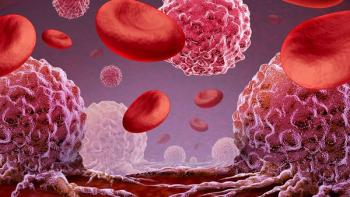Patients with unresectable hepatocellular carcinoma (HCC; liver cancer) tended to live longer without their disease getting worse when Imfinzi (durvalumab) and Avastin (bevacizumab) was added to transarterial chemoembolization (TACE), compared to those who received TACE alone, according to findings from the phase 3 EMRALD-1 clinical trial presented at the 2024 Gastrointestinal Cancers Symposium.
- Adding Imfinzi (durvalumab) and Avastin (bevacizumab) to the standard TACE therapy for liver cancer resulted in patients living longer without their disease progressing, compared to those receiving TACE alone.
- The study suggests that the combination of Imfinzi and Avastin with TACE has the potential to set a new standard of care for patients with unresectable hepatocellular carcinoma eligible for embolization.
- The addition of Imfinzi and Avastin did not introduce new safety concerns, and the side effects were consistent with the known profiles of these medications. Patients reported manageable side effects, and the study will continue to monitor overall survival and long-term outcomes.
At the final analysis of progression-free survival (PFS; the time patients live after treatment without their disease worsening), the median PFS was 15 months with Imfinzi and Avastin plus TACE (given to 204 patients) compared to 8.2 months with TACE alone (205 patients), resulting in a 23% reduction in the risk of progression or death with the two systemic therapies. The 12- and 18-month PFS rates were 55.5% and 43.1% with durvalumab and bevacizumab vs 39.8% and 28.3% with TACE alone, respectively. Similar PFS benefit was seen across most prespecified subgroups.
“(Imfinzi) plus (Avastin) in combination with TACE has the potential to set a new standard of care in unresectable HCC eligible for embolization,” Dr. Riccardo Lencioni, lead study author and professor in the Department of Surgery, Medical, Molecular, and Critical Area Pathology at Università di Pisa in Italy, said in a presentation of the data.
For more than two decades, TACE has been a standard treatment for patients with embolization-eligible unresectable HCC despite the commonality of disease progression within one year of therapy. Given the efficacy of checkpoint inhibitors and VEGF inhibitors in advanced HCC and the resulting proinflammatory tumor microenvironment and increased VEGF signaling following embolization, investigators hypothesized that the addition of Imfinzi and/or Avastin could lead to prolonged tumor response.
The double-blind, global, placebo-controlled phase 3 trial enrolled patients eligible for embolization with unresectable measurable HCC per modified RECIST criteria, Child-Pugh A to B7 liver function, an ECOG performance status of 0 or 1 (indicating that they could independently perform their daily tasks), and no evidence of disease outside of the liver.
Patients who were candidates for curative therapy with surgical resection, ablation or transplantation; those who received prior systemic therapy or TACE; and those with grade 3 or 4 portal vein thrombosis were excluded from enrollment.
Eligible patients (616) were randomly assigned to one of three groups: Imfinzi plus Avastin and TACE (arm B); Imfinzi plus TACE (arm A); or TACE alone (arm C). The protocol allowed investigator’s choice of conventional TACE or TACE with drug-eluting beads.
The primary end point was PFS for the Imfinzi, Avastin and TACE arm vs the TACE-alone arm. Secondary end points included PFS for durvalumab plus TACE vs TACE alone, overall survival (OS; time from treatment until death of any cause), objective response rate (ORR; percentage of patients whose disease shrunk or disappeared from treatment), time to progression (TTP), safety, and quality of life for Imfinzi, Avastin and TACE vs Imfinzi and TACE vs TACE alone.
Patients underwent imaging for tumor assessment at week 12 and every nine weeks thereafter.
Stratification factors included TACE modality (DEB-TACE vs cTACE), geographical region (Japan vs Asia vs other) and portal vein invasion (Vp1 or Vp2+ / -Vp1 vs none).
Demographic and baseline features were generally balanced across arms. Most patients in the Imfinzi and Avastin arm had BCLC stage B disease (57.4%) followed by stage A (25.0%) and stage C (17.2%). More than half of patients across arms A, B and C received cTACE (59.4%; 58.3%; 58.5%). Approximately half of patients received treatment in Asia (52.1%; 52.4%; 52.1%), and most patients did not have portal vein invasion (93.7%; 92.2%; 93.7%).
Across all three arms, most patients had received one or two TACE procedures. A total of 43.6%, 42.5%, 40.0% of patients in the Imfinzi and Avastin, Imfinzi and TACE-alone arms remain on study, respectively, and 14.0%, 13.0%, and 13.5% of whom continue to receive Imfinzi.
The data cutoff date for the final PFS analysis, presented here with an approximate target maturity of 72%, and the interim OS analysis, was Sept. 11, 2023. At the time of data cutoff, OS was not statistically significant.
Additional results showed that the median PFS with the addition of Imfinzi to TACE was 10 months vs 8.2 months with TACE alone, failing to meet the secondary end point for PFS. This means that the researchers could not confidently say that one of the two regimens was superior in this instance.
The median TTP was improved with the addition of Imfinzi and Avastin to TACE vs TACE alone but not with Imfinzi alone. The median TTP was 22 months with Imfinzi and Avastin vs 10 months with TACE alone. The median TTP was 11.5 months with Imfinzi vs 10 months with TACE alone.
Regarding responses, the ORR was 43.6% with Imfinzi and Avastin, 41% with Imfinzi, and 29.6% with TACE alone. Notably, complete responses across the three arms were rare, with partial responses representing 40.6%, 39.5% and 27.1% of responses in the Imfinzi/Avastin, Imfinzi and TACE-alone arms, respectively. Stable disease lasting at least 20 weeks occurred in 22.3%, 20.5% and 31.0% of patients, respectively.
The median duration of response was 22.1 months, 14.0 months and 16.4 months with Imfinzi and Avastin, Imfinzi, and TACE alone, respectively.
“The median time from the start of TACE to the first dose of the combination therapy was similar across the three arms (at approximately three months),” Lencioni said. “However, the duration of exposure was longer in the post-TACE period as well as across the total study in the (Imfinzi) and (Avastin) arm, consistent with the PFS in these patients.”
Regarding safety, no new signals were identified. Within the safety analysis sets of the Imfinzi and Avastin (154 patients), Imfinzi (232 patients) and TACE alone (200 patients) arms, 45.5%, 27.6%, and 23.0% of patients had grade 3/4 (moderate to severe) side effects. Side effects leading to discontinuation occurred in 24.7%, 12.1% and 7.0% of patients, respectively. Deaths occurred in the Imfinzi and Avastin, Imfinzi, and TACE alone arms, at rates of 24.7% (38 patients), 12.1% (28 patients) and 7.0% (14 patients), respectively.
Some of the most common treatment-side effects of any grade reported in the Imfinzi and Avastin arm included hypertension (27.3%), post-embolization syndrome (26.6%), hypothyroidism (22.7%), pruritus (21.4%), protein in the urine (21.4%) and constipation (18.8%). Grade 3/4 side effects in this arm included hypertension (5.8%), anemia (4.5%), acute kidney injury (3.9%), protein in the urine (3.9%), post-embolization syndrome (3.2%), hepatic encephalopathy (3.2%), ascites (2.6%), hyponatremia (2.6%), and esophageal varices hemorrhage (2.6%).
“The incidence of (side effects) was consistent with the duration of treatment exposure and the known safety profiles of (Imfinzi, Avastin) and TACE, and the incidence of maximum grade 3 or 4 (side effects) was low across all arms,” Lencioni stated.
The study remains blinded to investigators and participants and follow-up will continue for OS.
For more news on cancer updates, research and education, don’t forget to subscribe to CURE®’s newsletters here.






